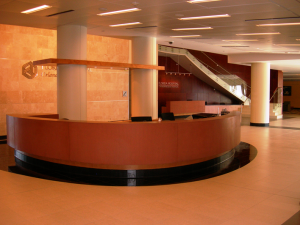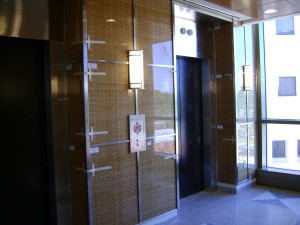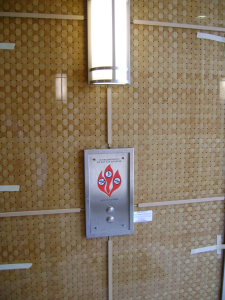How to Succeed in Architectural Woodworking
Guest Post by Pat Mullery
I have been fortunate to be in a business I really enjoy for more than 25 years and I have generally found that being more inclusive in scoping a job rather than less inclusive has gotten me more work and more profitable (and interesting) work as a result.
Sometimes we have bitten off more than we should have but we have a tendency to at least look at unusual requests when bidding our millwork projects. We will generally pick up glass, decorative metal, stone, solid surface and have actually done a few decorative concrete projects. We find that the GCs look at us in a different way when we include those finishes and the end result is usually a more uniform fit and finish between all the finishes we do provide.
If a GC is doing a plain vanilla cabinet job he may ask us for a price but to be competitive we have to bid against shops with less capabilities and less overhead which makes our profit margin less than theirs if we are the successful bidder. If the job has a more challenging scope that includes blueprint panels or acoustical panels, there are less potential bidders and we can price the job with a higher profit margin as a result. There are times when we are underbid by the smaller shops on the more challenging scopes but the GCs learn when it is time to perform why the smaller shop bid so low; they did not really know what they were getting into.
If our GCs start to think of us as their primary resource for unusual finishes that has a tendency to shift the project into more of a negotiation than a competitive bid. While that is not always the case, when there is enough work for our competition to get a larger market share in their comfort zone we have less and less competition in the higher end of the finish spectrum. They are just too busy doing what they do best.
Times change and styles change. Being able to roll with the changes makes us more competitive when pursuing the unique, high profit work. We already know that there is a learning curve associated with the changing materials and methods and rather than being intimidated we embrace the change and quickly become the local expert.
Don’t reject work simply because you haven’t done that type of work before, do some research and you will probably find there are resources to help you. We did not understand decorative concrete the first time we included it but we learned fast and listened closely to the decorative concrete subcontractor.
This is our first attempt at a decorative concrete desk. And you can see in the foreground and background two of the four desks on this project.
Not long after that project we were working on another hospital and were asked to pick up the elevator lobby panels on 4 patient floors. We didn’t refuse simply because we had never done anything like it before; we researched it, talked to the manufacturer and came up with a plan.
This is the first project we did with these laminated decorative glass panels. There are a total of 600 panels on this project, all tempered, laminated panels with cherry veneer basket weave in the laminate layer. The edges are covered by 3/16†at each edge. Every one of the 600 panels fit right the first time. The reason we were asked to do the job is visible in the close-up below, the glass contractor was intimidated by it and claimed it was not a glass panel but more of a wood panel.
The basket weave pattern is continuous vertically and horizontally from one panel to the next. We templated all 600 panels and installed all the glass and the stainless steel trim. We did not have to make any panels twice. It was the largest project of this type that the manufacturer had done and the glass contractor had nothing to do with it.
This is our competitive advantage; we research new materials, come up with a plan and hit it out of the ballpark more often than not. You might say we are not in the business of cabinets and millwork but more in the business of problem solving. That is an interesting and profitable business to be in.
About the Author
Pat Mullery is a Project Manager at Creative Concepts of Orlando, Inc. Pat has been in the cabinet and architectural millwork business for over 25 years with a short detour into theme park equipment manufacturing. In previous lives, Pat has been an aircraft electrician on AV8A Harriers and a prototype builder of defense department equipment.
Would you like to submit an article? Email us at zclip@monarchmetal.com



